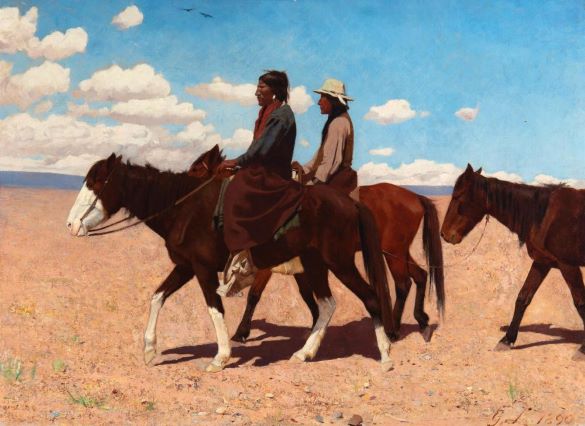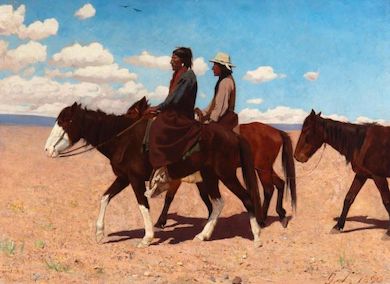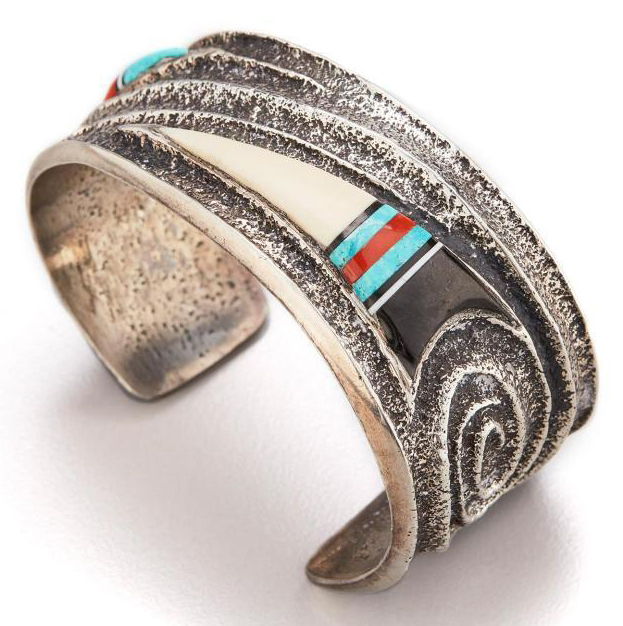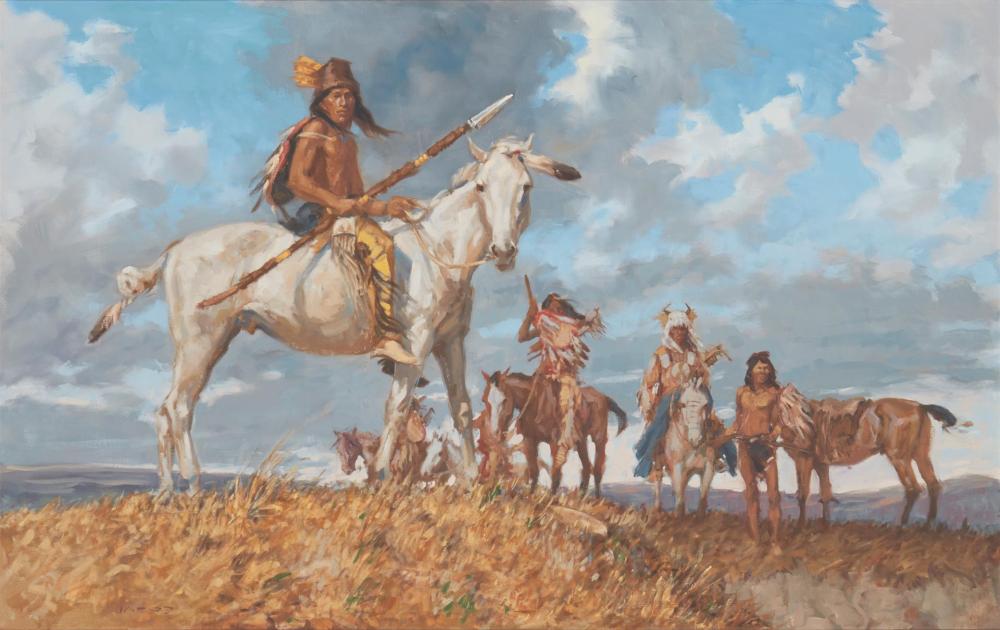
MONROVIA, Calif. – On May 25, the spirit of the wild west flowed through the 10,000-square-foot showroom at John Moran Auctioneers during its Art of the American West sale. Cowboys and American Indians played nicely through paintings and bronze sculptures, but there was a showdown of epic proportions between bidders participating on every platform available. Beautiful hand-woven rugs, blankets, and baskets had a 100% sell-through rate, and contemporary Western artwork earned its place next to historical depictions of the West, placing bright splashes of color next to rich browns and reds.
Accessories on offer included a sandcast cuff by Preston Monongye, a Los Angeles native who was adopted by a notable Hopi family after being abandoned at the Hopi Reservation as a child. After studying under his uncle, a prominent silversmith and painter, Monongye later became a leading voice in what is commonly referred to as the New Indian Jewelry movement. The sandcast cuff, inlaid with bone, turquoise, onyx, and coral points, was an excellent example of his work, and it exceeded its $3,000-$5,000 to sell for $5,312.
Items for display in the home such as pottery and textiles proved to be very desirable to buyers as seen in a Laguna Pueblo polychrome pottery Olla that dates to the early 20th century. Featuring a stylized floral motif in a colorful array of red, orange, black, and cream, it surpassed its $1,200-$1,800 estimate to sell for $4,062.

A wonderful selection of American Indian textiles performed well in the auction, most notably a Navajo crystal room-sized rug. Its bold geometric design, with diamond shapes and fretted elements, sold for $11,875 against a $2,000-$3,000 estimate.
Baskets were also a hot commodity during the sale boasting a 100% sell-through rate, and coming in a variety of shapes, patterns, and sizes. The Yokuts were an American Indian tribe originating from the San Joaquin Valley of California. When the Spanish settlers arrived in 1772, their estimated population numbered into the tens of thousands, however, their current populace is, unfortunately, a mere fragment of that amount. The Yokuts were known for executing beautifully crafted polychrome baskets and the Yokuts polychrome pictorial basket offered in the sale depicted both figures and stylized trees in an alternating pattern. The excellent example made by master weavers was estimated at $1,200-$1,800 but sold for $5,312.

A central California basketry bowl with alternating bands of vertical and horizontal zigzags sold for $4,687, well above its $600-$800 estimate. Several Mission baskets were included in the sale each with varying motifs. A standout was a Cahuilla Mission polychrome snake motif basket. The deep circular basketry tray was adorned with a coiled rattlesnake and radiating bands that imitated the vibrations of the rattle. The lot slithered past its $1,200-$1,800 estimate and sold for $7,500.
The sale lineup featured plenty of art in both the traditional and contemporary categories. Contemporary cowboy and artist Bill Owen (1942-2013) learned firsthand about life on the ranch and art simultaneously through his cowboy father and artist mother, which explains why his depictions feel so genuine. In 1973 he became a member of the Cowboy Artists of America and served three times as its president. The Arizona artist received several awards and exhibited internationally but founding The Arizona Cowpuncher’s Scholarship Organization in 1995 was one of his proudest accomplishments which provided college funds for youngsters in the Arizona ranching community. Owen’s drawing, First Saddle, did exceptionally well, selling for $10,000 against its $2,000-$3,000 estimate.
Henry Chapman Ford (1828-1894) was born in Livonia, New York, and spent several years studying art in Paris. He returned to the United States and enlisted in the Union Army to serve during the Civil War, and the illustrated press published his drawings of military life throughout his service. However, his most recognized artistic endeavor was the work on offer, a complete portfolio of Etchings of the Franciscan Missions of California. The 24 matted drypoint etchings on Japanese paper came in a leather-bound portfolio case accompanied by 28 pages outlining the history and descriptions of each mission site. The etchings were quite the undertaking, made possible when the artist devoted two summers in 1880 and 1881 to travel by horse and buggy to each mission site south of Santa Barbara, California, where he would make pencil drawings and painted sketches in preparation. The impressive body of work was estimated at $20,000-$30,000 but sold for $34,375.

Ned Jacob (b.1938) was also well-traveled. He grew up in New Jersey but hitchhiked all the way from the east coast to the great state of Montana, equipped with only $50 and his high school diploma. He had many teachers who helped him to hone his drafting skills as an artist, but living among the Blackfeet Indian tribe was perhaps the biggest contribution to his education and ability to capture the essence of American Indian life with such accuracy. The Kiowas, alternately entitled War Party (as written on the back of the stretcher bar) feels like a movie still, romantically portraying the grandeur of the west and its early inhabitants. It was a favorite among buyers selling for $9,375, far above its $2,000-$3,000 estimate.
Another revered Western artist represented in the sale was Gaspard de Latoix (British, 1858-1918). In 1880, along with his longtime partner, Isabell, ventured from England to America. Upon discovering the West, the self-taught draftsman dedicated his life and career to portraying New Mexico, the Plains Indians, and similar subject matter. Two Indians on Horseback is a striking example of the artist’s work, featuring rich earth tones in both the subjects and their horses, in contrast to the cool cerulean blue sky. The arresting painting roused fierce bidding that took it beyond its $15,000-$20,000 estimate to sell at $37,500.
[av_button label=’Click to view the auction catalog complete with prices realized’ icon_select=’no’ icon=’ue800′ font=’entypo-fontello’ link=’manually,https://www.liveauctioneers.com/catalog/203144_art-of-the-american-west/?keyword=&page=1′ link_target=’_blank’ size=’small’ position=’center’ label_display=” title_attr=” color_options=” color=’theme-color’ custom_bg=’#444444′ custom_font=’#ffffff’ btn_color_bg=’theme-color’ btn_custom_bg=’#444444′ btn_color_bg_hover=’theme-color-highlight’ btn_custom_bg_hover=’#444444′ btn_color_font=’theme-color’ btn_custom_font=’#ffffff’ id=” custom_class=” av_uid=’av-882gwsj’ admin_preview_bg=”]
View top auction results on LiveAuctioneers here: https://www.liveauctioneers.com/pages/recent-auction-sales/







